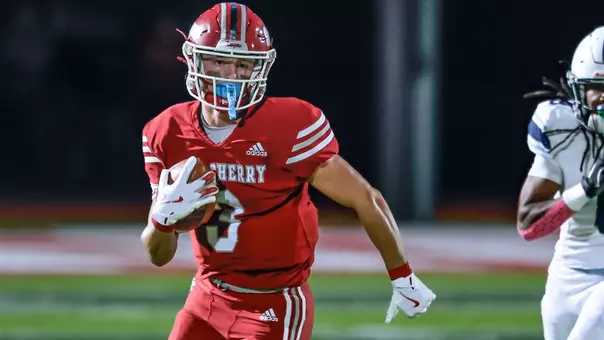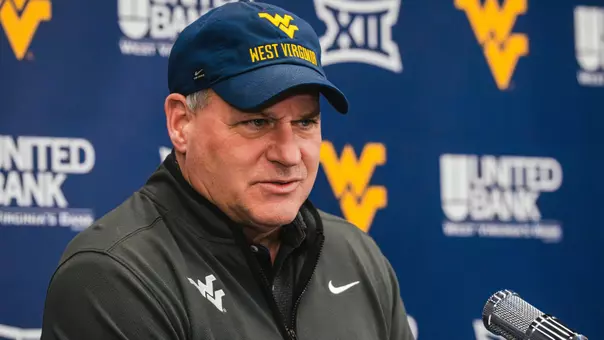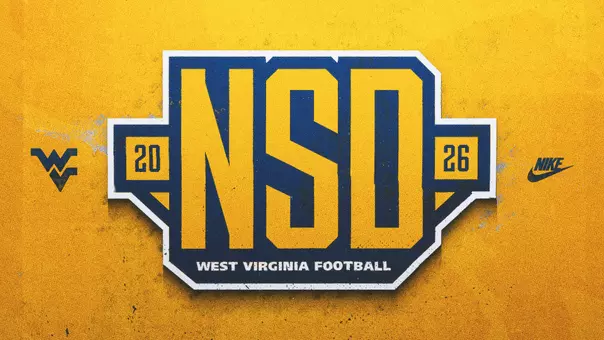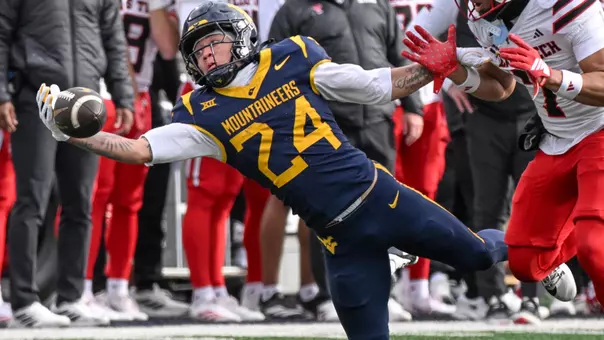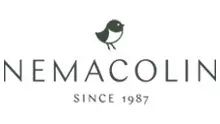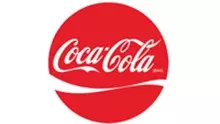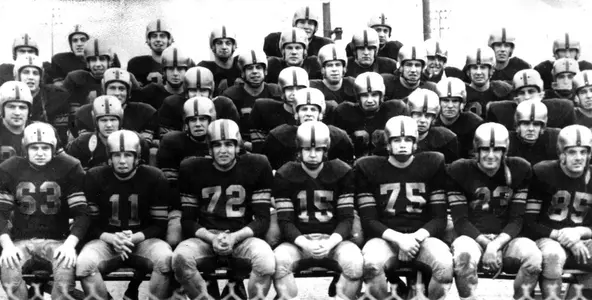
Sweet as Sugar: The 70th Anniversary of West Virginia’s Sugar Bowl Season
July 07, 2023 04:30 PM | Football, Blog
MORGANTOWN, W.Va. – This season marks the 70th anniversary of West Virginia University’s 1953 football team that won eight regular season games and was invited to play Georgia Tech in the 1954 Sugar Bowl in New Orleans.
It was the first major bowl appearance for the Mountaineers after 60 years of gridiron play, some of those lean and depressing.
When Mississippi State line coach Art Lewis was the surprise choice to lead the program in 1950, following Dudley DeGroot’s two tumultuous seasons at the helm, he made one promise to West Virginians – he was going to do everything in his power to keep the state’s best high school football players home.
Year after year, West Virginians watched their homegrown boys lead rival programs to great success, whether it was Oak Hill High’s George Cafego at Tennessee, Elkins High’s Marshall “Biggie” Goldberg at Pitt or Weir High’s Bob Gain at Kentucky. In fact, one year a Tennessee team consisting of nearly a dozen West Virginians faced Rice in the Orange Bowl.
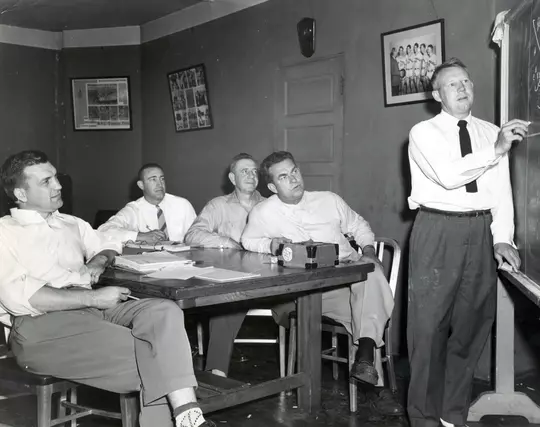
It may have seemed like a near miracle to the thousands of West Virginians who swarmed into the Stadium yesterday that their Mountaineers defeated Pitt for the second consecutive time - for it hadn't happened for 30 years - but it was anything but that.-- Chester L. Smith, Pittsburgh Press Sports Editor
Lewis’ first recruiting class in 1950 resulted in only modest success. Charleston’s Tommy Allman and Mt. Hope’s Jack Stone were the two plums, and the next year, following a 2-8 season, Lewis managed to land Wellsburg’s Gene “Beef” Lamone, but the big harvest had eluded him.
That finally changed in the summer of 1952. Lewis fought off dozens of schools to convince the state’s top prospect, Huntington’s Bobby Moss, to sign with the Mountaineers. He also landed the best player in North Central West Virginia, Farmington’s Sam Huff, discovered quarterback Freddy Wyant playing on a two-win team at Weston High, and unearthed a barrel-chested farm boy named Bruce Bosley over in Green Bank. And, just across the state line in Fredericktown, Pennsylvania, Lewis stole fullback Joe Marconi away from Maryland.
More than 70 years later, it is still considered the greatest recruiting class in school history.
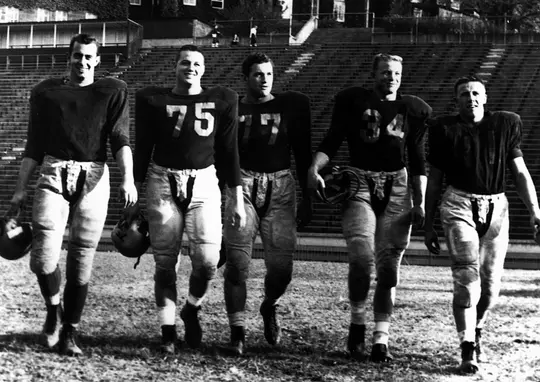
This group of players helped West Virginia win seven football games in 1952 and crack the Associated Press top 20 rankings for the first time in school history. With nearly everyone returning, even greater things were expected of Lewis’ fourth team in 1953.
A couple of events away from the playing field greatly impacted West Virginia’s season. The first occurred in January of that year when the NCAA abolished the free substitution rule allowing the use of two-platoon football, first introduced by Michigan.
Lewis had taken great advantage of the two-platoon system by developing two fully intact units of offensive and defensive players. Some of those impacted, such as safety Bob Snider, linebacker Don Wilson and defensive back Bill Jarrett, excelled specifically on defense and were relegated to the bench in 1953 because the players in front of them were considered much better offensive players.
“We go into our second year in 1953 and we’ve got 21 of 22 starters back,” Wyant once recalled. “The NCAA changed the rules and 10 of those kids couldn’t play. You couldn’t get into the game. You almost had to die to get out of the game.”
Then, later that spring, seven key members of the Southern Conference - Clemson, Maryland, South Carolina, North Carolina, Duke, NC State and Wake Forest - announced at the league meetings held at Sedgefield Country Club in Greensboro, North Carolina, that they were leaving immediately. The Southern Conference’s two football powers, Clemson and Maryland, were adamantly opposed to a conference-wide decision not to participate in bowl games, and when both accepted bowl invitations in 1951, they were effectively blackballed by the league.
Maryland didn’t play a single Southern Conference opponent in 1952 while Clemson faced just one – rival South Carolina - and both spent the year exploring their options. Clemson’s and Maryland’s solution to their dilemma was to join North Carolina, NC State, Duke, Wake Forest and South Carolina in new league, which became known as the Atlantic Coast Conference.
Ironically, two of the leading members of the league’s anti-bowl delegation, North Carolina and Duke, opted to join forces with Maryland and Clemson. Virginia was later added that fall to make eight schools, while West Virginia and Virginia Tech remained under heavy consideration as its ninth and 10th members.
Naturally, West Virginia was caught off guard when the seceding schools announced their departures and WVU athletic director Legs Hawley spent the rest of the year walking a fine line between supporting the current conference and putting out feelers to the new league.
But neither West Virginia nor Virginia Tech could garner enough support for a variety of reasons. In West Virginia’s case, the public explanation given was the great distance from Morgantown to the other schools in the ACC. The city didn’t have access to a fully equipped airport nor an adequate highway system, making weekly road trips to West Virginia unpractical.
Privately, WVU officials suspected the school’s land-grant institution status also had something to do with the decision, along with a festering dispute with Maryland, which began when the Terps called into question the eligibility status of some of West Virginia’s wartime players in 1947 and continued in 1951 when WVU retaliated by supporting the Southern Conference’s anti-bowl legislation.
“(Maryland coach) Jim Tatum was not a fan of West Virginia,” late Morgantown Post sports editor Tony Constantine recalled in 2001. “Maryland was invited to play in the (Sugar Bowl), and at the time, it had to be approved by vote from the other conference members and WVU refused to approve. Tatum never forgot that.”
Duke, North Carolina, Wake Forest and Clemson were not part of West Virginia’s annual football slate, but Maryland was, and removing the Terps from the schedule eliminated a major obstacle to having a great season.
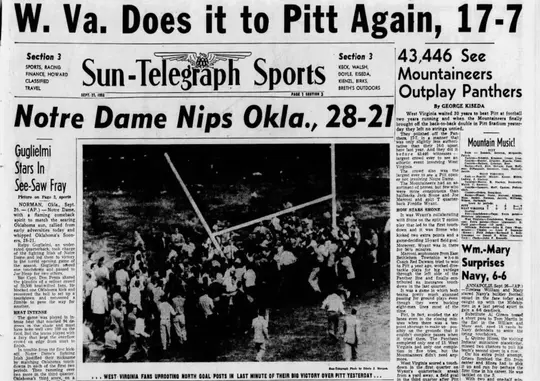
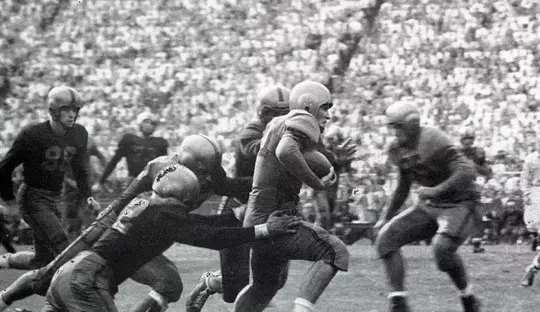
The biggest challenges West Virginia faced in 1953 were games at Pitt and Penn State, and a home contest against South Carolina near the end of the season. The Mountaineers were heavily favored to defeat the other six opponents and began the year in the national rankings for the first time ever at No. 16 in the AP poll.
The season opener at Pitt on Saturday, Sept. 26, featured the largest crowd to ever watch a regular season West Virginia football game (43,456) with an estimated 10,000 of them traveling to the Steel City from the Mountain State. In fact, traffic on Route 51 was so heavy through Uniontown, Pennsylvania, that Lewis arrived late for the game and nearly missed the kickoff.
Pitt concentrated its efforts on stopping West Virginia’s trap plays and the running of quarterback Fred Wyant, but left its flanks exposed to Wyant’s option pitches to running backs Marconi and Jack Stone, which led to 269 yards on the ground and a surprising 17-7 victory. Marconi was fabulous, rushing 19 times for 104 yards and scoring the deciding 10-yard touchdown in the fourth quarter. Stone carried 11 times for 94 yards and booted a 25-yard field goal in the third quarter. Wyant, who completed just one pass for 17 yards, produced the game’s first touchdown on a short first-quarter plunge.
“In some respects, it was a weird game, which marked the return of platoon-less football to the local college scene,” Pittsburgh Press sports editor Chet Smith wrote afterward. “The old rivals exchanged fumbles, intercepted passes and engaged in gambling that bordered on the reckless side to provide a show that was as eye-filling as it was disappointing to the Panthers.”
Lewis admitted the new substitution rule impacted his decision making. “It sort of gets you fouled up,” he said. “There were times today when I took out a player and something happened to his replacement, and I had to go for No. 3 instead of back to No. 1 during the period. Sure, it makes for a different game.”
A week later, a better-than-usual crowd of 18,000 watched West Virginia easily defeat Waynesburg College 47-19 with Lewis getting many of his reserve players into the game. Fifteen different players carried the football and five different players scored rushing touchdowns, led by Carl Norman’s 11-carry, 108-yard, one-touchdown effort. All three Waynesburg scores came through the air, two from the arm of halfback Herb Forse, in the fourth quarter. Pass defense would be West Virginia’s Achilles heel throughout the season.
Old rival Washington and Lee made its second-ever appearance in Morgantown on Saturday, Oct. 10, with six West Virginians in its starting lineup. Norman replaced an injured Marconi at right halfback, and he responded with a team-best 95 yards and a touchdown a 40-14 victory. Another strong rushing performance made up for a struggling West Virginia aerial attack that was off target nine times in 13 attempts with one interception.
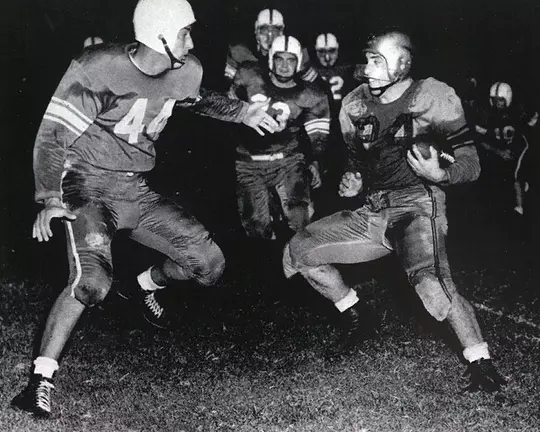
George Washington, the top passing team in the Southern Conference, was played a week later at Washington, D.C.’s Griffith Stadium without top ball-hawk Bob Snider, who was lost for the season to military service. Norman scored twice, once on a 15-yard interception return and later a 10-yard run, and Wyant hit Stone on a 53-yard scoring toss in West Virginia’s 27-6 victory. WVU’s pass defense, spotty in its first three games of the season, limited GW’s Ray Fox to just six completions in 31 attempts for 122 yards and three interceptions.
Against VMI, West Virginia led 33-0 at halftime, which enabled backups to get most of the action in the second half. Seldom-used quarterback Ted Anderson, who handled the football just 17 times the two prior seasons, ran nine times for a record 205 yards and a pair of touchdowns. Three of the Mt. Hope native’s runs covered distances of 71, 59 and 40 yards. The Mountaineers finished the afternoon with 584 total yards, 485 of those coming on the ground.
Now ranked in the top five in the two major polls for the first time, the Mountaineers withstood a record 247-yard passing performance from Penn State’s Tony Rados to knock off the Nittany Lions 20-19 before 25,000 at Beaver Field on Saturday, October 31. The Lions took a 12-6 halftime lead on Rados’ 46-yard pass to Dick Jones across the middle of the field, but WVU struck back with a pair of third-quarter scores.
The first came on a 1-yard plunge by Wyant, followed by Bruce Bosley’s blocked punt that he scooped up and returned 13 yards into the end zone to give WVU a 20-12 lead. Penn State added a late touchdown on Rados’ 20-yard pass to Ron Younker but was unable to tie the game because the two-point conversion rule was not yet enacted.
Bosley earned Associated Press “Linemen of the Week” honors for his performance and was one of four Mountaineers to play all 60 minutes. Wyant, Lamone and end Joe Papetti were the others. It was just West Virginia’s second-ever win at Beaver Field, and it marked the first time the Mountaineers defeated Pitt and Penn State in the same season. A deciding factor in the victory was a pair of wayward Penn State conversion kicks by Jim Garrity and Bill Strauh.
End Bill Marker had a great performance by hauling in a 64-yard touchdown pass from Wyant and finishing with five catches for 126 yards.
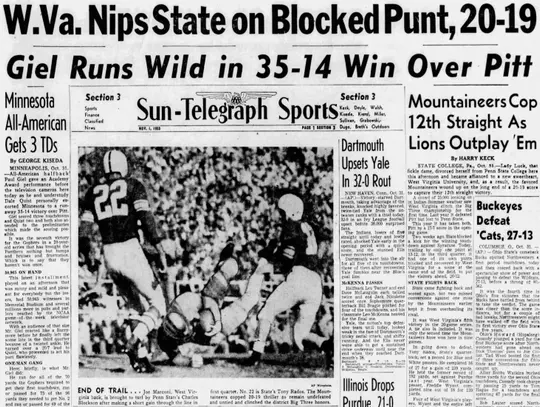
A crazy bounce of a football kept 25,000 veering from delirium to despair at Beaver Field today, and the Old Nittany Lion, limp with exhaustion, is mournfully silent tonight. West Virginia beat Penn State, 20-19.-- Art Morrow, Philadelphia Inquirer Sports Reporter
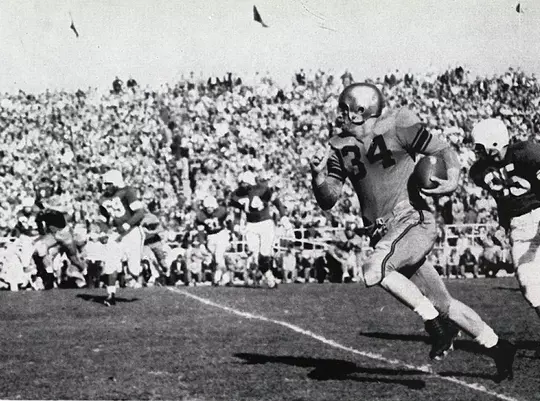
A week later, in what was clearly a trap game at 10,000-seat Mitchell Stadium in Bluefield, fullback Tommy Allman played a key role in the Mountaineers’ come-from-behind 12-7 victory over Virginia Tech. The Gobblers crossed the goal line first in the second quarter to take a 7-0 lead, but Allman reached pay dirt twice after intermission and finished with a career-best 139 yards. His first score came on a 6-yard run in the third quarter, and then he added the deciding tally when he raced 39 yards to the end zone. Both of West Virginia’s conversion kicks were missed.
Dropping to No. 8 in the AP poll, West Virginia put its nation’s best 12-game winning streak on the line at home against South Carolina before a near-sellout crowd of 32,000. But Gamecock quarterback Johnny Gramling was not affected by the raucous atmosphere nor the Mountaineer pass defense in leading South Carolina to a 20-14 upset victory. Gramling scored twice in the first half on short touchdown runs, and added a 25-yard TD toss to Gene Wilson in the third quarter to give South Carolina a comfortable 20-7 lead.
West Virginia turned the football over three times inside the Gamecock 20, twice on fumbles and once on an errant Wyant pass. Otherwise, West Virginia had the statistical advantage in total yardage (239-209) in a battle of two top-10-ranked defenses. The strong turnout helped West Virginia set a single season attendance record of 22,000, eclipsing the 1949 team’s average of 16,500 per game.
According to the late Eddie Barrett, West Virginia’s sports information director at the time, the Mountaineers were told they needed a dominant performance at one-win NC State in their season-ending game to remain in contention for the Sugar Bowl’s other open slot opposite unanimous choice Georgia Tech.
Any doubt about the game’s outcome was taken care of in the second quarter when West Virginia erupted for 27 points, and Lewis poured it on in the second half to impress Sugar Bowl scouts among the scant 5,800 in attendance at Riddick Stadium. West Virginia tallied four more scores after intermission, including touchdown runs by regulars Allman and Marconi, in a 61-0 rout.
WVU put up nearly 600 total yards against the woeful Wolfpack, including 84 yards on just three carries by backup fullback Danny Williams. Wyant completed eight-of-10 passes for 116 yards and a touchdown, and Allman was the only WVU player to cross the goal line twice, once in the first quarter on a 21-yard run and later in the third quarter on a 26-yard burst. State, which defeated only Davidson that season, finished the contest with just three first downs and 89 net yards on 44 offensive plays.
West Virginia's big Mountaineers, with an eye cast on a Sugar Bowl bid, exploded for 27 points in the second period and went on to smother North Carolina State, 61-0, today in a tremendous display of power.-- Associated Press
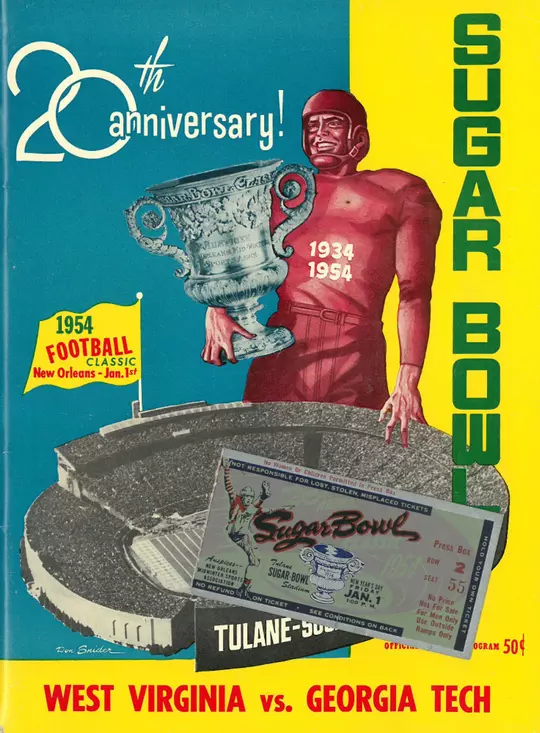
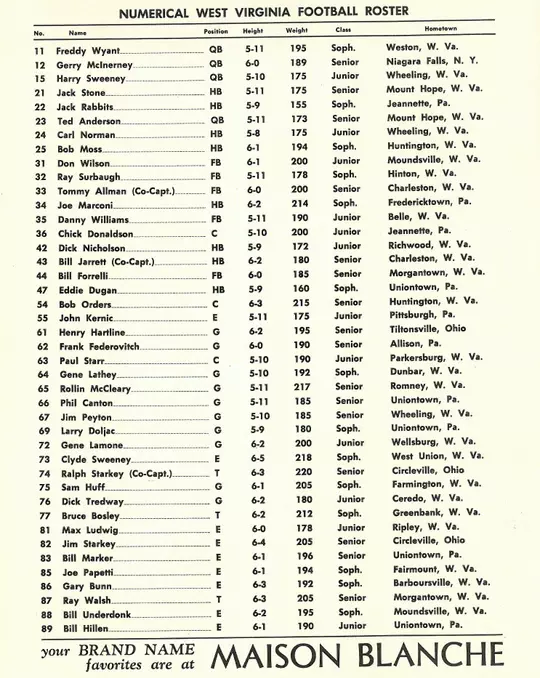
Still, despite West Virginia’s 8-1 record, the Sugar Bowl committee had reservations about inviting the Mountaineers because of their weakened schedule in a watered-down Southern Conference. There were several attractive Southwest teams still available, including Texas, Baylor and Texas Tech, but a late PR push by Barrett got the Mountaineers enough votes in the two major polls to remain in the top 10. That was certainly helpful.
The Southern Conference also changed its stance on accepting bowl bids once it became clear how much the league stood to benefit financially from West Virginia’s invitation. According to the Charleston Daily Mail, the Southern Conference took 75% of the bowl share, which amounted to $75,000. The Mountaineers netted approximately $25,000 after being allocated $40,000 for their travel costs to New Orleans.
New Orleans Item sportswriter Hap Claudi mocked West Virginia’s selection and began referring to the game as the “Lemon Bowl.” Steve Perkins, also of the Item, was more subdued but equally skeptical that West Virginia could give Georgia Tech a good game.
“I was hoping I’d feel, after watching (West Virginia) practice, that they could beat Tech, for that victory would be popular around here, but I can’t,” he told Morgantown Post sports editor Tony Constantine before the game. “I don’t mean West Virginia doesn’t have a chance - any team has that. But it just isn’t on par with Tech.”
Lewis, aware of the criticism, felt compelled to take his team down to Biloxi, Mississippi, two full weeks before the game for additional training. No one could ever recall a coach doing this, and many believed the difficult two-a-day practices had a negative impact on the team’s performance against Georgia Tech.
“The second week we practiced all of the time in the cold and then we go to New Orleans, and we stay in an Army barracks,” Wyant recalled in 2005. “The guys on the second floor roasted and the guys on the first floor froze to death. The next day, the temperature went from us working out in 40-degree weather in Biloxi to whatever it was in New Orleans.”
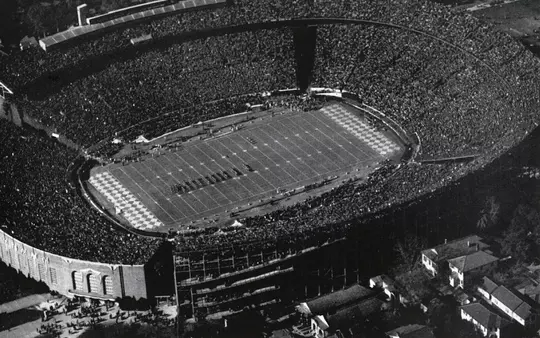
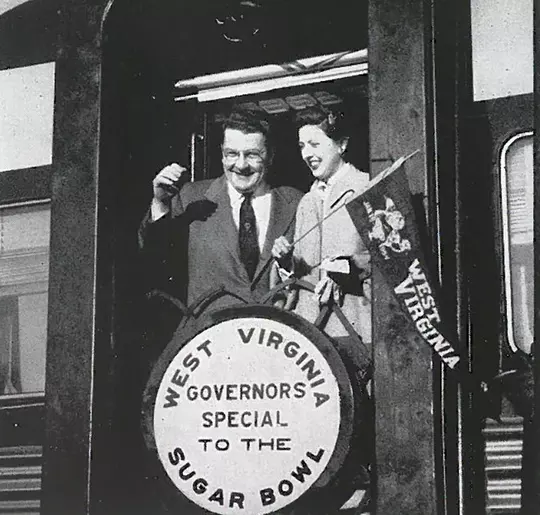
Georgia Tech had tremendous speed and plenty of athletes, but statistically it wasn’t considered a great passing team, so Lewis figured the best way of stopping them was to bring more players up to the line of scrimmage and keep the Yellow Jackets from getting to the outside on end runs.
After studying film of West Virginia’s games, Tech coach Bobby Dodd decided he was going to throw the football instead of running it against the Mountaineers’ great size up front. Quarterback Pepper Rodgers executed the plan to perfection, completing 16 of his 26 pass attempts for 195 yards and three touchdowns. Tech scored twice on touchdown throws in the first quarter and built a 20-6 halftime lead.
A key moment came early in the second quarter when the Mountaineers were trailing 14-6 and had an opportunity to get back in the game. Wyant tried a long fourth-down pass to halfback Joe Marconi that he couldn’t secure in the end zone that would have reduced Tech’s lead to just one point.
“If Marconi doesn’t miss that pass, we’re right back in the game,” Wyant recalled.
Georgia Tech took over at its 12 and marched the length of the field to score its third touchdown of the half, a Rodgers-to-Henry Hair 5-yard pass with only 40 seconds left. Nine more Tech points in the third quarter put the game out of reach.
“They were every bit as fast as we expected they’d be, but those passes caught us flat,” Lewis said after the game. “Our boys couldn’t get their reflexes working fast enough to stop that constant air attack. That’s what beat us.”
West Virginia ran for 223 yards, but Wyant struggled to keep up with Rodgers’ passing, the sophomore completing just four-of-15 for 29 yards with two interceptions. WVU turned the ball over six times in the 42-19 defeat.
“They were a good, big team,” Georgia Tech’s Dodd said, “but they couldn’t cover our receivers. We were too fast for them, while they seemed sluggish at times. We opened up quick and just kept going.”
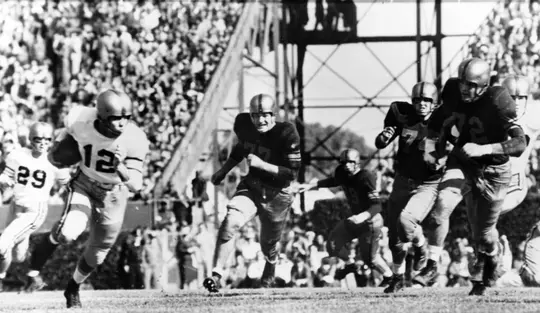
Afterward, several West Virginia players were recognized for their outstanding seasons. Center Bob Orders earned NEA first team All-America honors and was a third team choice by United Press International.
Bosley and Lamone were second team All-America picks, while Wyant and Orders were named to Collier’s All-East team. Six players - Wyant, Orders, Lamone, Bosley, Allman and Marker - made first team All-Southern Conference and all 11 starters made one of the three all-conference teams.
Allman won the Jacobs Blocking Trophy as the top blocker in the Southern Conference and was invited to play in the Senior Bowl. Eight players were drafted by NFL teams, with Allman going the highest to the Green Bay Packers in the fourth round.
The Mountaineers ranked third in total offense (377.6), fourth in rushing defense (108.3), fifth in rushing offense (281.8) and 10th in total defense (203.9) that season.
It would take West Virginia another 35 years to return to a major bowl when it faced top-ranked Notre Dame in the 1989 Sunkist Fiesta Bowl in Tempe, Arizona.
The team held reunions periodically through the years, including 2003 on its 50th anniversary. Sadly, most of the key members are now deceased. Marconi was among the the first to die, succumbing to cancer in 1992, and Bosely died of a heart attack three years later in 1995.
Allman died in 1996, Orders in 2014 and Moss in 2018. Stone passed away in 2020, and two years ago, Wyant and Huff died within a span of eight months.
Today, Beef Lamone is believed to be the only surviving starter from the team.

